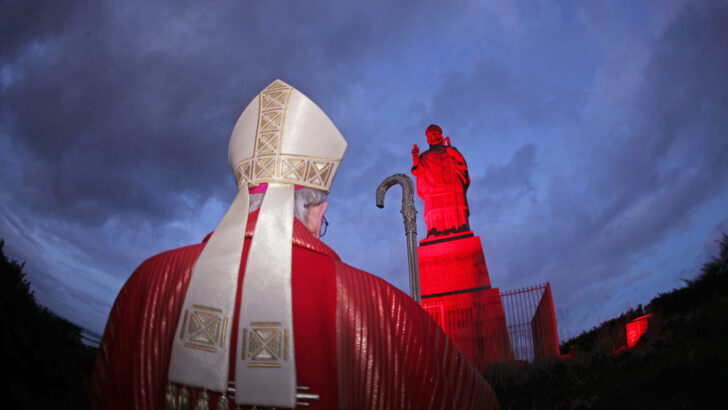Two bishops stood on Co. Down hillside, facing each other, both draped in blood red, the colour of the martyr.
It was a poignant scene at the weekend, as the Bishop of Down and Connor pondered the stone monument of St Patrick, which was illuminated in red, as the sun went down at Saul, the place where Ireland’s patron saint first proclaimed: ‘Is tighearna Íosa Críost!’
Those words which we take for granted – “Jesus Christ is Lord!” – can still get you persecuted, jailed, or even killed in many countries around the world.
As Bishop Alan McGuckian pondered St Patrick’s monument, which rises 47 feet on Slieve Patrick, he was keenly aware that he was about to address Mass goers in the church below. He also knew that, among them, were the descendants of those who were first to hear and believe those revolutionary words.
“We lit up Patrick’s statue in red tonight,” Bishop McGuckian told the congregation at the vigil Mass, “and it will remain lit up for the week in solidarity with the Christians persecuted to this day. Some people think there could be 250 Christians suffering violence even unto death every single day. There are 50 countries in the world where Christians are regularly persecuted and dying often.”
“So this week you will look up at the mountain and you will see it at night, all in red. Remember to pray for our brothers and sisters all over the world who at this very moment, this very day, are being persecuted for boasting that ‘Jesus Christ is Lord’.”
Although the monument, which was built in the 1930s to mark the 1500th anniversary of St Patrick’s arrival in 432AD, is lit green annually, this is the first time the status has been lit red for the ‘Week of Witness’. This week is organised by the pontifical charity, Aid to a Church in Need (ACN) which supports 6,000 vulnerable communities in 140 countries.
The lighting, like the statue itself, was a labour of love, through the efforts of parishioners, the diocese, the local Knights of St Columbanus (CK12) and the generosity of a Belfast company NIAVAC (Audio Visual Ltd).
Reflection
In a passionate plea, the Bishop of Down and Connor urged those who passed the monument this week to reflect on what it means to follow Christ.
“Every time you look up there, let it not be ‘oh woe is us, we are being persecuted’. Look up, stand in solidarity and feel yourself called to be a witness to the truth that Jesus Christ is Lord!”
Bishop Alan reminded Mass-goers that martyr simply means ‘witness’.
And he told a powerful story of a polish nun who was visited by the SS in her convent when the Nazis invaded.
The SS man said to the nun: “In ten years, you will be honouring Hitler on those altars where you now honour Jesus Christ.”
The nun retorted:“When Hitler dies on a cross for his people and three days later rises from the dead, I will wear a Nazi uniform rather than my habit.”
The Bishop recalled the great tradition of Christians saying ‘Jesus Christ is Lord.’
“Men, women and children in their droves died because they would not stop saying ‘Jesus Christ is Lord’ and that is part of our story. The important thing is that not just that we resist but that this boast of ours ‘Jesus Christ is Lord’ touches our hearts because we know we have a God who is close to us and who loves us.”
This tradition in Ireland dates to the fifth century when St Patrick was himself put in chains for the sake of the Gospel – and condemned the ‘evil of evil people’ who had ambushed a group of newly baptised Christians.
Some who live among us today have first hand stories of violent persecution. Indeed Bishop McGuckian, as Bishop of Raphoe, spoke of a Nigerian priest who regularly received news from home about clergy, and catechumens being killed.
This week on Red Wednesday, November 20, the Colosseum, where early Christians were fed to the lions, was among landmarks lit red.
In the modern age, we have television images of slaughtered Christians.
Who could forget, asked Bishop McGuckian, the martyrdom of Coptic Christians, murdered in Libya for their faith in 2017?
“Twenty-one construction workers,” said Bishop McGuckian, “Regular guys”.
Ragheed Ganni, a Chaldaen Catholic priest, served at St Patrick’s Sanctuary of Lough Derg and was well-known and respected among clergy in Down and Connor.
Bishop Alan McGuckian reminded us all of his martyrdom, after he returned home to Iraq. He was killed, along with three deacons, on Trinity Sunday, 2007, because he defied a death threat and witnessed that ‘Jesus Christ is Lord’ by celebrating Mass.
The Congregation for the Causes of Saints has opened Fr Ragheed’s cause for beatification, and declared him a Servant of God.
As Bishop McGuckian spoke of Fr Ragheed, that great tradition of Christians saying ‘Jesus Christ is Lord’ came alive.
In the month of remembrance, it is good to remember that we worship a God of the living, a God in whom we find safety.
At the foot of Slieve Patrick, where St Patrick began and ended his earthly mission in Ireland, the parishioners were left to ponder what it really means to declare ‘Jesus Christ is Lord’.
“Please God,” declared Bishop Alan, “None of us will have to die for this but it would be wonderful if we were able to live for it. Because if our faith is worth dying for, it is all the more worth living for.”
So, as a dear nun and friend used to say, “Let us live well, so we can die well.”


 Martina Purdy
Martina Purdy Bishop of Down and Connor, the Very Reverend Alan McGuckian, at the illumination in red of the world's tallest statue of St Patrick last night. Bishop McGuckian gave permission for the Saul monument at Slieve Patrick, County Down, Ireland to be lit red, the colour of martyrdom, for the first time in solidarity with persecuted Christians. Cathedrals, Churches and landmarks such as the Colosseum in Rome are lit red at the invitation of the charity, Aid to a Church in Need, which organises an annual Week of Witness particularly on Red Wednesday (November 20). Saul Monument, which rises to 47 feet, was built in the 1930s to mark the 1500th anniversary of St Patrick's arrival in the area to begin his Christian mission in Ireland in 432AD.After visiting the monument, Bishop McGuckian told parishioners at the vigil mass at St Patrick's, Saul: " Remember to pray for our brothers and sisters all over the world who at this very moment, this very day, are being persecuted for boasting that ÔJesus Christ is LordÕpicture Bill Smyth use photo for free
Bishop of Down and Connor, the Very Reverend Alan McGuckian, at the illumination in red of the world's tallest statue of St Patrick last night. Bishop McGuckian gave permission for the Saul monument at Slieve Patrick, County Down, Ireland to be lit red, the colour of martyrdom, for the first time in solidarity with persecuted Christians. Cathedrals, Churches and landmarks such as the Colosseum in Rome are lit red at the invitation of the charity, Aid to a Church in Need, which organises an annual Week of Witness particularly on Red Wednesday (November 20). Saul Monument, which rises to 47 feet, was built in the 1930s to mark the 1500th anniversary of St Patrick's arrival in the area to begin his Christian mission in Ireland in 432AD.After visiting the monument, Bishop McGuckian told parishioners at the vigil mass at St Patrick's, Saul: " Remember to pray for our brothers and sisters all over the world who at this very moment, this very day, are being persecuted for boasting that ÔJesus Christ is LordÕpicture Bill Smyth use photo for free 